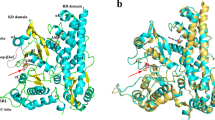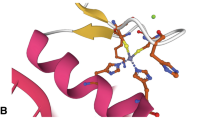Abstract
Inhibitory effect of Zn on the pyruvate kinase of M (muscle)-type isozyme was analyzed for the purpose of elucidating the cytotoxicity of Zn. Zn inhibited pyruvate kinase uncompetitively with respect to the substrate PEP, and competitively with respect to ADP. Quotient velocity plot calculated from the Zn-inhibition curves showed that Zn2+ as a ZnADP complex acted as competitive and uncompetitive inhibitors of the enzyme with respect to the substrate ADP and PEP, respectively: Zn2+ forms a ZnADP complex, which may bind to the ADP-binding site of the free enzyme with the Ki value of 1.4 μM causing competitive inhibition, or to the ADP-site of the enzyme-PEP complex with 2.6 μM resulting in uncompetitive inhibition. The inhibition of pyruvate kinase by Zn2+ may be responsible for the cytotoxicity of this metal by decreasing glycolytic flux.





Similar content being viewed by others
References
Ainsworth S, Macfarlane N (1973) A kinetic study of rabbit muscle pyruvate kinase. Biochem J 131:223–236
Canzoniero LM, Turetsky DM, Choi DW (1999) Measurement of intracellular free zinc concentrations accompanying zinc induced neuronal death. J Neurosci 19((1-6)):31
Clower CV, Chatterjee D, Wang Z, Cantley LC, Heiden MGV, Krainer AR (2010) The alternative splicing repressors hnRNP A1/A2 and PTB influence pyruvate kinase isoform expression and cell metabolism. Proc Natl Acad Sci USA 107:1894–1899
Dawson RMC, Elliott DC, Elliott WH, Jones KM (1986) Stability constants of metal complexes. Data for Biochemical Research, 3rd edn. Clarendon Press, Oxford, pp 399–415
Feksa LR, Cornelio AR, Dutra-Filho CS, Wyse ATS, Wajner M, Wannmacher CMD (2003) Characterization of the inhibition of pyruvate kinase caused by phenylalanine and phenylpyruvate in rat brain cortex. Brain Res 968:199–205
Frederickson CJ, Giblin LJ, Krezel A, McAdoo DJ, Mueller RN, Zeng Y, Balaji RV, Masalha R, Thompson RB, Fierke CA, Sarvey JM, de Valdenebro M, Prough DS, Zornow MH (2006) Concentrations of extracellular free zinc (pZn)e in the central nervous system during simple anesthetization, ischemia and reperfusion. Exp Neurol 198:285–293
Fukada T, Yamasaki S, Nishida K, Murakami M, Hirano T (2011) Zinc homeostasis and signaling in health and diseases: Zinc signaling. J Biol Inorg Chem 16:1123–1134
Gazaryan IG, Krasnikov BF, Ashby GA, Thorneley RNF, Kristal BS, Brown AM (2002) Zinc is a potent inhibitor of thiol oxidoreductase activity and stimulates reactive oxygen species production by lipoamide dehydrogenase. J Biol Chem 277:10064–10072
Gazaryan IG, Krasinskaya IP, Kristal BS, Brown AM (2007) Zinc irreversibly damages major enzymes of energy production and antioxidant defense prior to mitochondrial permeability transition. J Biol Chem 282:24373–24380
Goldberg ND, Passonneau JV, Lowry OH (1966) Effect of changes in brain metabolism on the levels of citric acid cycle intermediates. J Biol Chem 241:3997–4003
Huang EP (1997) Metal ions and synaptic transmission: think zinc. Proc Natl Acad Sci USA 94:13386–13387
Krotkiewska B, Banaś T (1992) Interaction of Zn2+ and Cu2+ ions with glyceraldehyde-3-phosphate dehydrogenase from bovine heart and rabbit muscle. Int J Biochem 24:1501–1505
Maret W, Jacob C, Vallee BL, Fischer EH (1999) Inhibitory sites in enzymes: zinc removal and reactivation by thionein. Proc Natl Acad Sci USA 96:1936–1940
Murakami K, Tsubouchi R, Fukayama M, Qiao SL, Yoshino M (2009) Iron-dependent oxidative inactivation with affinity cleavage of pyruvate kinase. Biol Trace Elem Res 130:31–38
Noguchi T, Inoue H, Tanaka T (1986) The M2- and M1-type isozymes of rat pyruvate kinase are produced from the same gene by alternative RNA splicing. J Biol Chern 261:13807–13812
O’Halloran TV (1993) Transition metals in control of gene expression. Science 261:715–725
Pivovarova NB, Stanika RI, Kazanina G, Villanueva I, Andrews SB (2014) The interactive roles of zinc and calcium in mitochondrial dysfunction and neurodegeneration. J Neurochem 128:592–602
Sensi SL, Paoletti P, Bush A, Sekler I (2009) Zinc in the physiology and pathology of the CNS. Nat Rev Neurosci 10:780–791
Sheline CT, Behrens MM, Choi DW (2000) Zinc-induced cortical neuronal death: Contribution of energy failure attributable to loss of NAD+ and inhibition of glycolysis. J Neurosci 20:3139–3146
Tornheim K (1980) Co-ordinate control of phosphofructokinase and pyruvate kinase by fructose diphosphate: a mechanism for amplification and step changes in the regulation of glycolysis in liver. J Theor Biol 85:199–222
Tsutsumi H, Tani K, Fujii H, Miwa S (1988) Expression of L- and M-type pyruvate kinase in human tissues. Genomics 2:86–89
Vallee BL, Auld DS (1992) Active zinc binding sites of zinc metalloenzymes. Matrix Suppl 1:5–19
Vallee BL, Falchuk KH (1993) The biological basis of zinc physiology. Physiol Rev 73:79–118
Yamada K, Noguchi T (1999) Regulation of pyruvate kinase M gene expression. Biochem Biophys Res Commun 256:257–262
Yamada K, Noguchi T, Matsuda T, Takenaka M, Monaci P, Nicosia A, Tanaka T (1990) Identification and characterization of hepatocyte-specific regulatory regions of the rat pyruvate kinase L gene. The synergistic effect of multiple elements. J Biol Chem 265:19885–19891
Yoshino M, Murakami K (2009) A graphical method for determining inhibition constants. J Enz Inh Medic Chem 24:1288–1290
Yu Q, Kandegedara A, Xu Y, Rorabacher DB (1997) Avoiding interferences from Good’s buffers: a contiguous series of noncomplexing tertiary amine buffers covering the entire range of pH 3–11. Anal Biochem 253:50–56
Author information
Authors and Affiliations
Corresponding author
Ethics declarations
Conflict of interest
The authors report no conflicts of interest.
Rights and permissions
About this article
Cite this article
Murakami, K., Yoshino, M. Zinc inhibition of pyruvate kinase of M-type isozyme. Biometals 30, 335–340 (2017). https://doi.org/10.1007/s10534-017-0009-y
Received:
Accepted:
Published:
Issue Date:
DOI: https://doi.org/10.1007/s10534-017-0009-y




